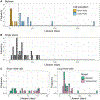Quantifying the Dynamics of HIV Decline in Perinatally Infected Neonates on Antiretroviral Therapy
- PMID: 32576731
- PMCID: PMC8818299
- DOI: 10.1097/QAI.0000000000002425
Quantifying the Dynamics of HIV Decline in Perinatally Infected Neonates on Antiretroviral Therapy
Abstract
Background: Mathematical modeling has provided important insights into HIV infection dynamics in adults undergoing antiretroviral treatment (ART). However, much less is known about the corresponding dynamics in perinatally infected neonates initiating early ART.
Setting: From 2014 to 2017, HIV viral load (VL) was monitored in 122 perinatally infected infants identified at birth and initiating ART within a median of 2 days. Pretreatment infant and maternal covariates, including CD4 T cell counts and percentages, were also measured.
Methods: From the initial cohort, 53 infants demonstrated consistent decline and suppressed VL below the detection threshold (20 copies mL) within 1 year. For 43 of these infants with sufficient VL data, we fit a mathematical model describing the loss of short-lived and long-lived infected cells during ART. We then estimated the lifespans of infected cells and the time to viral suppression, and tested for correlations with pretreatment covariates.
Results: Most parameters governing the kinetics of VL decline were consistent with those obtained previously from adults and other infants. However, our estimates of the lifespan of short-lived infected cells were longer than published values. This difference may reflect sparse sampling during the early stages of VL decline, when the loss of short-lived cells is most apparent. In addition, infants with higher pretreatment CD4 percentage or lower pretreatment VL trended toward more rapid viral suppression.
Conclusions: HIV dynamics in perinatally infected neonates initiating early ART are broadly similar to those observed in other age groups. Accelerated viral suppression is also associated with higher CD4 percentage and lower VL.
Figures





References
-
- Global Burden of Disease Collaborative Network. Global, regional, and national age-sex-specific mortality for 282 causes of death in 195 countries and territories, 1980–2017: a systematic analysis for the Global Burden of Disease Study 2017. Lancet. 2018;392(10159):1736–1788. doi:10.1016/S0140-6736(18)32203-7. - DOI - PMC - PubMed
-
- Global Burden of Disease Collaborative Network. Global Burden of Disease Study 2017 (GBD 2017) Results; 2018. Available from: http://ghdx.healthdata.org/gbd-results-tool.
Publication types
MeSH terms
Substances
Grants and funding
LinkOut - more resources
Full Text Sources
Medical
Research Materials

